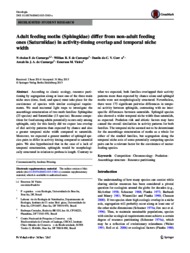Adult feeding moths (Sphingidae) differ from non-adult feeding ones (Saturniidae) in activity-timing overlap and temporal niche width.
Adult feeding moths (Sphingidae) differ from non-adult feeding ones (Saturniidae) in activity-timing overlap and temporal niche width.
Author(s): CAMARGO, N. F. de; CAMARGO, W. R. F. de; CORREA, D. do C. V.; CAMARGO, A. J. A. de; VIEIRA, E. M.
Summary: Abstract According to classic ecology, resource partitioning by segregation along at least one of the three main niche axes (time, food, and space) must take place for the coexistence of species with similar ecological requirements. We used nocturnal light traps to investigate the assemblage structuration of two moth families: Sphingidae (23 species) and Saturniidae (13 species). Because competition for food among adults potentially occurs only among sphingids, only for this family did we expect less overlap of diel activity patterns than expected by chance and also a greater temporal niche width compared to saturniids. Moreover, we expected a greater number of sphingid species pairs to differ in activity timing compared to saturniid pairs. We also hypothesized that in the case of a lack of temporal structuration, sphingids would be morphologically structured in relation to proboscis length. Contrary to what we expected, both families overlapped their activity patterns more than expected by chance alone and sphingid moths were not morphologically structured. Nevertheless, there were 173 significant pairwise differences in temporal activity between sphingids, contrasting with no interspecific differences between saturniids. Sphingid species also showed a wider temporal niche width than saturniids, as expected. Predation risk and abiotic factors may have caused the overall similarities in activity patterns for both families. The temporal niche seemed not to be determinant for the assemblage structuration of moths as a whole for either of the studied families, but segregation along the temporal niche axis of some potentially competing species pairs can be a relevant factor for the coexistence of nectarfeeding species.
Publication year: 2016
Types of publication: Journal article
Unit: Embrapa Cerrados
Observation
Some of Embrapa's publications are published as ePub files. To read them, use or download one of the following free software options to your computer or mobile device. Android: Google Play Books; IOS: iBooks; Windows and Linux: Calibre.
Access other publications
Access the Agricultural Research Database (BDPA) to consult Embrapa's full library collection and records.
Visit Embrapa Bookstore to purchase books and other publications sold by Embrapa.

